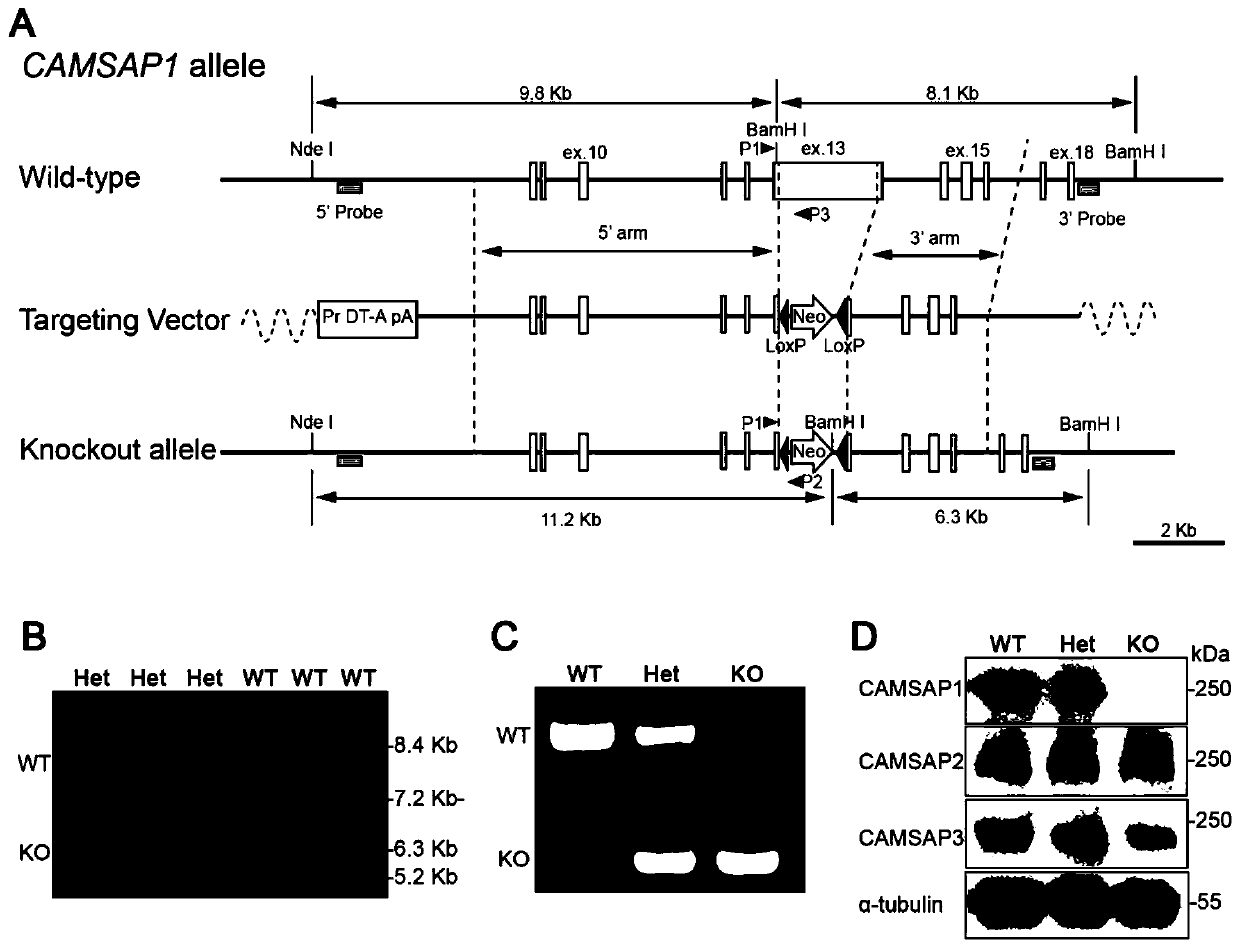CAMSAP1 protein and application of gene thereof as epileptic drug target
A protein and target technology, used in drug combinations, compound screening, peptide/protein components, etc., can solve problems such as weak depolymerization ability
- Summary
- Abstract
- Description
- Claims
- Application Information
AI Technical Summary
Problems solved by technology
Method used
Image
Examples
Embodiment 1
[0205] Embodiment 1, the impact of CAMSAP1 protein on mouse body weight and survival time
[0206] 1. Construction of CAMSAP1 knockout mice
[0207] To construct CAMSAP1 knockout mice, the 13th exon of CAMSAP1 was selected as the target site and knocked out by homologous recombination ( figure 1 Middle A).
[0208] The vector used for homologous recombination (targeting vector) is: DT-A-pA / loxP / PGK-Neo-pA / loxP, such as figure 1 As shown in A, the vector contains the homologous sequences (5'arm and 3'arm) on both sides of the Camsap1 gene mutation site, and the inserted loxP-Neo-loxP sequence. The expression of CAMSAP1 was terminated prematurely due to the insertion of Neo.
[0209] 2. Detection of CAMSAP1 in CAMSAP1 knockout mice
[0210] 1. The CAMSAP1 gene was detected in wild-type mice, CAMSAP1 knockout mice and heterozygous mice by Southern hybridization. The probe sequences for Southern hybridization are shown in SEQ ID NO: 3 (5'probe) and SEQ ID NO: 4 (3'probe), res...
Embodiment 2
[0232] Embodiment 2, the distribution of CAMSAP family protein in cerebral cortex and neuron
[0233] 1. Expression of CAMSAP family proteins detected by Western blot
[0234] Previous studies have shown that CAMSAP family proteins are expressed in the rat brain, but CAMSAP2 is mainly expressed, CAMSAP1 and CAMSAP3 are less expressed, especially the expression of CAMSAP1 is extremely weak, and the expression of CAMSAP1 is not detected in the hippocampus. Therefore, firstly, whether CAMSAP1 protein is expressed in the mouse central nervous system was detected.
[0235] The total protein of the cerebral cortex, hippocampus of different periods and hippocampal neuron cells cultured for different periods were extracted respectively, and detected by Western blot using CAMSAP1 antibody, CAMSAP2 antibody and CAMSAP3 antibody respectively.
[0236] Figure 4 The upper panel in middle A shows the results of immunoblotting of the cerebral cortex, and the lower panel shows the percenta...
Embodiment 3
[0266] Example 3, CAMSAP1 participates in regulating the polarity establishment of neurons in vitro
[0267] 1. CAMSAP1 is involved in regulating the polarity establishment of hippocampal neurons in vitro
[0268] 1. The inventors of the present invention found through the co-staining of the neuron axon marker protein Tau-1 antibody and the dendrite marker protein Map2 antibody that compared with the cultured wild-type hippocampal neurons, the neurons after knocking out CAMSAP1 grew out The proportion of neurons with single axons (only one protrusion is Tau-1 positive) decreases and the proportion of neurons with multiple axons (multiple protrusions are Tau-1 positive) increases ( Figure 9 Middle A), the ratio of the first and second longest neurites, the longest neurite length, the total length of all neurites and the total number of neuron neurites all changed ( Figure 9 Middle C, D, E and F). This suggests that knocking out CAMSAP1 does alter neuronal polarity.
[0269...
PUM
 Login to View More
Login to View More Abstract
Description
Claims
Application Information
 Login to View More
Login to View More - R&D
- Intellectual Property
- Life Sciences
- Materials
- Tech Scout
- Unparalleled Data Quality
- Higher Quality Content
- 60% Fewer Hallucinations
Browse by: Latest US Patents, China's latest patents, Technical Efficacy Thesaurus, Application Domain, Technology Topic, Popular Technical Reports.
© 2025 PatSnap. All rights reserved.Legal|Privacy policy|Modern Slavery Act Transparency Statement|Sitemap|About US| Contact US: help@patsnap.com



